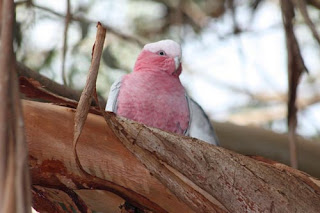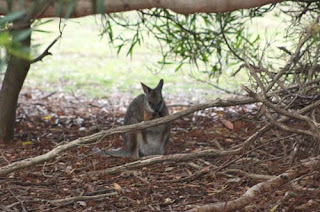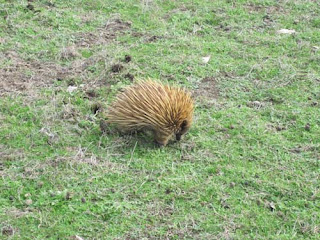Location: Karatta, Australia
Address: Hanson Bay Wildlife Sanctuary, South Coast Road
Date: May 2012
Website: www.hansonbay.com.au
One place we just had to visit while on Kangaroo Island was the Hanson Bay Wildlife Sanctuary. The sanctuary is home to a koala colony and other Australian wildlife. When we first entered the sanctuary we spotted a short beaked echidna digging in the grass. Once we had paid our admission fee we headed off towards Koala Walk.
As we entered the rows of eucalyptus trees we were greeted by a group of galahs. Galahs are also known as rose breasted cockatoos. They are a beautiful grey and pink with a lighter coloured forehead. They look a bit like someone has pulled a pink turtleneck up over their nose. Galahs can be found all across Australia and have become as common as pigeons are to other parts of the world.
Speaking of beautiful birds, we also spotted some crimson rosellas. Crimson Rosellas are a type of parrot that is blue and red. The ones found on Kangaroo Island are the largest in all of Australia. Rosellas are usually found in mating pairs like the two we photographed below.
After admiring the birds we looked up into the trees. Looking back at us was one of the resident koalas.
The koalas at Hanson Bay are a wild group that is free to leave at any time. Any one of them could have easily followed us to our car and out along the driveway to explore the rest of the island.
Koalas are a close relative of the wombat. They are both marsupials and both have backwards facing pouches. Wombat pouches face backwards to keep them from filling with dirt. Koala pouches face that way since the babies eat a substance called pap from their mother's butt. Anyway, wombats prefer digging in the ground while koalas spend most of their day sleeping high up in the eucalyptus trees. Despite their pouches facing in opposite directions both koala babies and kangaroo babies are called joeys.
We had a great time spotting koalas up in the trees. When our necks were sore it was time to look down again. Much to our delight there was more to explore at ground level.
Sitting underneath a branch is what we believe was a tammar wallaby. These are the smallest of all the wallabies and are quite common on Kangaroo Island.
Another macropod we spotted was the Kangaroo Island kangaroo. It is similar to the western grey kangaroo but is more chocolate coloured and much stockier. Macropod means large feet in Greek. We also had to move our feet as the afternoon was almost over. Hanson Bay Wildlife Sanctuary is on the western end of Kangaroo Island near Flinders Chase National Park and we had to drive all the way to Penneshaw at the eastern end. Anybody need a ride?
Map of Our World
 Hanson Bay Wildlife Sanctuary
Hanson Bay Wildlife SanctuaryPost # 119














